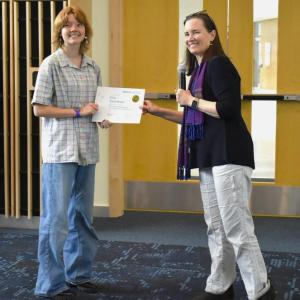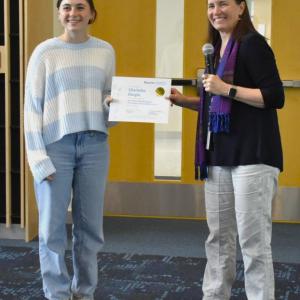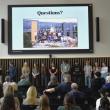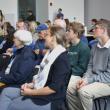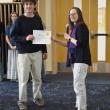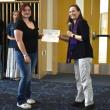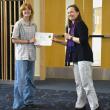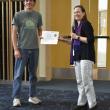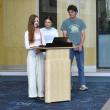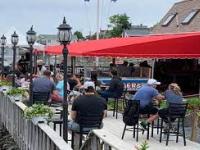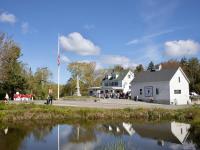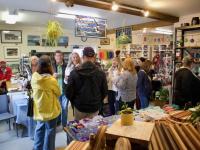Young minds bloom at week-long science program
 After a week-long crash course in marine science, Bigelow's Keller BLOOM students share their findings. ISABELLE CURTIS/Boothbay Register
After a week-long crash course in marine science, Bigelow's Keller BLOOM students share their findings. ISABELLE CURTIS/Boothbay Register
 BRHS junior Matthew Little answers audience questions. ISABELLE CURTIS/Boothbay Register
BRHS junior Matthew Little answers audience questions. ISABELLE CURTIS/Boothbay Register
 BLOOM program director Dr. Nicole Poulton welcomes friends and family to the talks. ISABELLE CURTIS/Boothbay Register
BLOOM program director Dr. Nicole Poulton welcomes friends and family to the talks. ISABELLE CURTIS/Boothbay Register
 ISABELLE CURTIS/Boothbay Register
ISABELLE CURTIS/Boothbay Register
 ISABELLE CURTIS/Boothbay Register
ISABELLE CURTIS/Boothbay Register
 Families reunite. ISABELLE CURTIS/Boothbay Register
Families reunite. ISABELLE CURTIS/Boothbay Register
 ISABELLE CURTIS/Boothbay Register
ISABELLE CURTIS/Boothbay Register
 ISABELLE CURTIS/Boothbay Register
ISABELLE CURTIS/Boothbay Register
 ISABELLE CURTIS/Boothbay Register
ISABELLE CURTIS/Boothbay Register
 ISABELLE CURTIS/Boothbay Register
ISABELLE CURTIS/Boothbay Register
 ISABELLE CURTIS/Boothbay Register
ISABELLE CURTIS/Boothbay Register
 ISABELLE CURTIS/Boothbay Register
ISABELLE CURTIS/Boothbay Register
 ISABELLE CURTIS/Boothbay Register
ISABELLE CURTIS/Boothbay Register
 ISABELLE CURTIS/Boothbay Register
ISABELLE CURTIS/Boothbay Register
 ISABELLE CURTIS/Boothbay Register
ISABELLE CURTIS/Boothbay Register
 ISABELLE CURTIS/Boothbay Register
ISABELLE CURTIS/Boothbay Register
 ISABELLE CURTIS/Boothbay Register
ISABELLE CURTIS/Boothbay Register
 ISABELLE CURTIS/Boothbay Register
ISABELLE CURTIS/Boothbay Register
 ISABELLE CURTIS/Boothbay Register
ISABELLE CURTIS/Boothbay Register
 ISABELLE CURTIS/Boothbay Register
ISABELLE CURTIS/Boothbay Register
 ISABELLE CURTIS/Boothbay Register
ISABELLE CURTIS/Boothbay Register
 ISABELLE CURTIS/Boothbay Register
ISABELLE CURTIS/Boothbay Register
 ISABELLE CURTIS/Boothbay Register
ISABELLE CURTIS/Boothbay Register
 ISABELLE CURTIS/Boothbay Register
ISABELLE CURTIS/Boothbay Register
 ISABELLE CURTIS/Boothbay Register
ISABELLE CURTIS/Boothbay Register
 ISABELLE CURTIS/Boothbay Register
ISABELLE CURTIS/Boothbay Register
 ISABELLE CURTIS/Boothbay Register
ISABELLE CURTIS/Boothbay Register
 ISABELLE CURTIS/Boothbay Register
ISABELLE CURTIS/Boothbay Register
 ISABELLE CURTIS/Boothbay Register
ISABELLE CURTIS/Boothbay Register
 ISABELLE CURTIS/Boothbay Register
ISABELLE CURTIS/Boothbay Register
 After a week-long crash course in marine science, Bigelow's Keller BLOOM students share their findings. ISABELLE CURTIS/Boothbay Register
After a week-long crash course in marine science, Bigelow's Keller BLOOM students share their findings. ISABELLE CURTIS/Boothbay Register
 BRHS junior Matthew Little answers audience questions. ISABELLE CURTIS/Boothbay Register
BRHS junior Matthew Little answers audience questions. ISABELLE CURTIS/Boothbay Register
 BLOOM program director Dr. Nicole Poulton welcomes friends and family to the talks. ISABELLE CURTIS/Boothbay Register
BLOOM program director Dr. Nicole Poulton welcomes friends and family to the talks. ISABELLE CURTIS/Boothbay Register
 ISABELLE CURTIS/Boothbay Register
ISABELLE CURTIS/Boothbay Register
 ISABELLE CURTIS/Boothbay Register
ISABELLE CURTIS/Boothbay Register
 Families reunite. ISABELLE CURTIS/Boothbay Register
Families reunite. ISABELLE CURTIS/Boothbay Register
 ISABELLE CURTIS/Boothbay Register
ISABELLE CURTIS/Boothbay Register
 ISABELLE CURTIS/Boothbay Register
ISABELLE CURTIS/Boothbay Register
 ISABELLE CURTIS/Boothbay Register
ISABELLE CURTIS/Boothbay Register
 ISABELLE CURTIS/Boothbay Register
ISABELLE CURTIS/Boothbay Register
 ISABELLE CURTIS/Boothbay Register
ISABELLE CURTIS/Boothbay Register
 ISABELLE CURTIS/Boothbay Register
ISABELLE CURTIS/Boothbay Register
 ISABELLE CURTIS/Boothbay Register
ISABELLE CURTIS/Boothbay Register
 ISABELLE CURTIS/Boothbay Register
ISABELLE CURTIS/Boothbay Register
 ISABELLE CURTIS/Boothbay Register
ISABELLE CURTIS/Boothbay Register
 ISABELLE CURTIS/Boothbay Register
ISABELLE CURTIS/Boothbay Register
 ISABELLE CURTIS/Boothbay Register
ISABELLE CURTIS/Boothbay Register
 ISABELLE CURTIS/Boothbay Register
ISABELLE CURTIS/Boothbay Register
 ISABELLE CURTIS/Boothbay Register
ISABELLE CURTIS/Boothbay Register
 ISABELLE CURTIS/Boothbay Register
ISABELLE CURTIS/Boothbay Register
 ISABELLE CURTIS/Boothbay Register
ISABELLE CURTIS/Boothbay Register
 ISABELLE CURTIS/Boothbay Register
ISABELLE CURTIS/Boothbay Register
 ISABELLE CURTIS/Boothbay Register
ISABELLE CURTIS/Boothbay Register
 ISABELLE CURTIS/Boothbay Register
ISABELLE CURTIS/Boothbay Register
 ISABELLE CURTIS/Boothbay Register
ISABELLE CURTIS/Boothbay Register
 ISABELLE CURTIS/Boothbay Register
ISABELLE CURTIS/Boothbay Register
 ISABELLE CURTIS/Boothbay Register
ISABELLE CURTIS/Boothbay Register
 ISABELLE CURTIS/Boothbay Register
ISABELLE CURTIS/Boothbay Register
 ISABELLE CURTIS/Boothbay Register
ISABELLE CURTIS/Boothbay Register
 ISABELLE CURTIS/Boothbay Register
ISABELLE CURTIS/Boothbay Register
May 23, students at Bigelow Laboratory’s Keller BLOOM program capped off their week-long immersive experience with a public presentation. The event also christened Bigelow’s new Harold Alfond Center for Ocean Education and Innovation.
For the past 35 years, the Keller BLOOM program has offered Maine high school juniors a chance to spend a week as a marine scientist, completing fieldwork, laboratory analysis and data presentation. This year’s 16-person group had representatives from eight counties, including Boothbay Region High School (BRHS) junior Matthew Little.
The team’s focus was the Sheepscot River. Field day was spent taking samples of phytoplankton (microscopic plant-like organisms) from four stations along the water body, starting in Wiscasset and ending in Southport. Students then spent a day analyzing samples and breaking down the results into four mini-presentations: physical data and nutrients, bacterial and viral concentrations, and phytoplankton and zooplankton populations.
Their conclusions showcased the interconnected nature of the ecosystems they were studying, finding that the increased oxygen, nitrate, nitrite, and phosphorus moving upriver towards the freshwater in Wiscasset resulted in larger zooplankton biomass. Decreases were observed when moving downriver, towards the Atlantic Ocean, in the form of lower bacterial concentration, silicon, fluorescence, and chlorophyll and zooplankton diversity.
Students also acknowledged a data “blip” that occurred at the salt wedge at Station Four; an area where denser, saltier water intrudes under lighter, fresh water. Organic matter and nutrients build up above this ocean layer. A similar spike should have occurred at Station Three, but the team accidentally measured at the wrong depth.
But data wasn't the only thing students took away from the experience.
Laughter filled the room as students shared some downtime behind the scenes, such as the week’s ping-pong wins (and woes). A similar audience reaction came from Ava Clapper of Falmouth High School’s observation: “My biggest takeaway is that you’re never alone when you’re in the water. You’ll always have plankton.”
Other common highlights included being surrounded by passionate, like-minded people, the plankton identification process and using laboratory equipment that is too expensive for a classroom setting.
“I really liked being in a lab where we had all the resources to explore what we were really interested in…(It) was a new and informative experience for me,” said Emmett Fay-Leblanc of Portland High School.
Charlotte Durgin of Scarborough High School said, “Putting on our lab coats for the first time and feeling like a real scientist. That was unforgettable.”
Bigelow also awards a $1,500 scholarship to a member of the previous year’s cohort for college-related expenses. The prize went to Emmett Appel of Erskine Academy.















